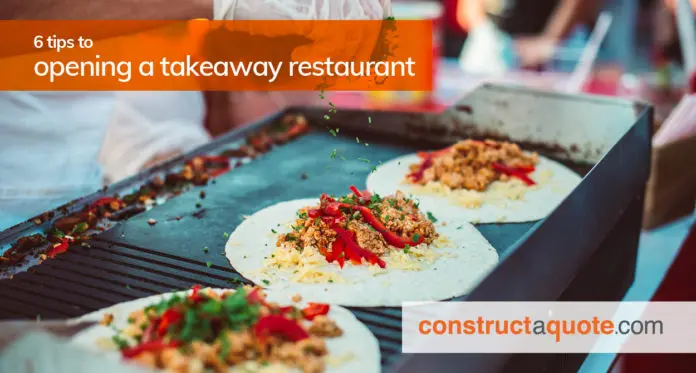by constructaquote - 9 June 2016


Takeaways are great businesses for many enterprising and hardworking people. They provide a popular service to a wide range of customers and the trend for eating out is on the up.
Running a takeaway can be exhausting as may involve long and unsociable hours depending on the business model, but it can be an extremely profitable investment if you get everything right. Before you take the plunge, here are six tips to help you get it right.
A takeaway prepares food that people collect and eat off the premises. A takeaway restaurant is somewhere offering this service but also the option to eat the same food in a restaurant or cafe environment.
Takeaway shops abound. There’s almost every kind of food you can imagine, from Fish and Chips to Thai and Malaysian. It’s really important, as with any business to know what the competition is and how crowded the market is. If you want to start a pizza delivery service make sure you’re not battling for business with several other businesses close by. If you can think of a new product to offer – something nobody else does in your area – so much the better. Think of something new – maybe a falafel shop or a vegetarian takeaway might hit the right note and attract good custom. Or instead of offering ‘the usual’ kind of burger, offer a handmade burger with 100% beef steak and all the trimmings in artisan bread.f
Whatever product you offer, you will need to find the right location and hit on the right trading times. Where you need to be located and the times that you do the most business will both depend on your product. There’s no point offering a sandwich delivery service in a residential area for example.
If you have a location in mind, make sure your product is a good fit for your catchment area. For example, if you are considering trading in an industrial area, your target market will be office and other workers.
Whatever location you choose be sure to check parking facilities and your immediate competition. If you are catering for lunchtime office workers find out about existing delivery services that supply offices directly – these may not be obvious and may be located far away.
With an idea of your location, think of your opening times. If you are serving office workers for example, it’s unlikely that you will make a sale before 8.30am or after 6pm or at weekends. A residential area will be different, most of your business will come from families and younger people, in the evenings and the weekend, 1pm to 10pm. If you’re in the centre of town, you may need to be open until 2 or 3am to catch the bulk of your trade as they leave the pubs and clubs for home.
Trading near pubs or nightclubs will differ again and with an adult clientele in need of quick, cheap eats, you’ll benefit by opening late,from early evening right up until 4 in the morning.
Just as for any business, getting the right insurance in place before you start trading is really important. Many insurers offer specialist takeaway insurance to make life easy. This type of insurance policy will generally include public liability insurance, employers’ liability insurance, building insurance, stock and contents insurance and even business interruptions. But before you buy a readymade package, be sure it meets your needs. You can increase the level of cover for example, and you may need to add other types of insurance, including van insurance, goods in transit insurance and to protect yourself, your family and your business if you are ill you may also want to consider income protection.
Because all premises preparing and selling food need to be licensed, you will need to apply for a change of use for your property if it isn’t already a takeaway or restaurant. Getting these planning consents in place can be costly and take a long time. So it’s a really good idea to find a building that’s had a food licence in the past. It will make everything a great deal quicker and easier.
You will need to learn basic food regulations including food hygiene and will also need to meet health and safety regulations. You will need all the relevant certificates in place before you start to trade. Your premises will also be spot checked by your local council’s environmental health department on occasion, so you will need to stick to all relevant health and safety and food hygiene guidelines.
If you are found to be in breach of these regulation or found to be unhygienic or unsafe you can be closed down.
Don’t feel that you have to learn through experience. Even though your business may be small, it’s still a business and there are many other small business out there that can share their experience and give you support. Join local networking groups or sigh up to an on line business network like Sunzu and get the encouragement and advice you need to build your business. Ultimately, the quality of your food, reliability of your deliveries and your own special customer service is what will make the difference to the success of your business. Treat every customer as if they were your first, deliver delicious food, on time and for a good price and you’ll quickly build a strong reputation that will see orders flying in.

by Charlotte Houghton - 7 October 2020
by constructaquote - 6 October 2020
by Charlotte Houghton - 29 September 2020
by Charlotte Houghton - 24 September 2020